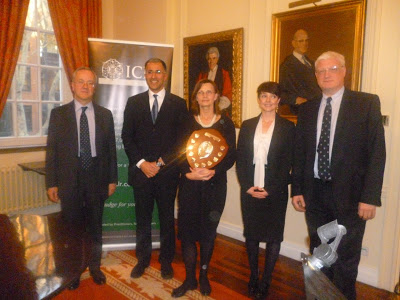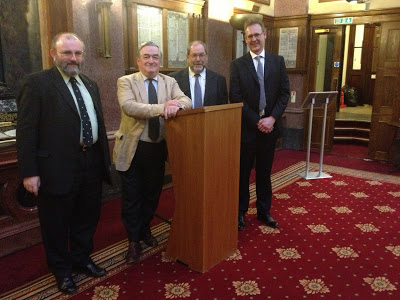Modern marriage defined: a spectrum that includes many shades of grey? A very Jamesian problem
At a time when Parliament is considering whether to legalise same-sex marriage, and when modern medicine has severed the links between sex and procreation, Sir James Munby, President of the Family Division, giving the latest ICLR Annual Lecture, pointed to the “immense gulf” which separates our world from that of the Victorians, and asked how
At a time when Parliament is considering whether to legalise same-sex marriage, and when modern medicine has severed the links between sex and procreation, Sir James Munby, President of the Family Division, giving the latest ICLR Annual Lecture, pointed to the “immense gulf” which separates our world from that of the Victorians, and asked how much of the traditional legal definition of marriage still survives today?
A few days later, in the ICLR Annual Mooting competition finals, the problem posed discussed how far the criminal law should go in controlling sadomasochism in the marital bedroom.

In his lecture, given at the Law Society on Thursday 25 April, Sir James (above) began by quoting the definition of marriage supplied by his namesake, Sir James Wilde, the Judge Ordinary in Hyde v Hyde and Woodmansee (1866) LR 1 PD 130, 133, as
“the voluntary union for life of one man and one woman, to the exclusion of all others.”
This definition, reported in the first volume of the newly-formed Council of Law Reporting’s reports from the Probate and Divorce courts, represented what the Victorians had thought of as the legal concept of marriage, whose purposes (expressed in the Book of Common Prayer) included the procreation of children, the avoidance of fornication, the mutual help and society of the spouses and, according to yet another Sir James (they seem to be sprouting everywhere in this court), Sir J Hannen, in Durham v Durham (1885) 10 PD 80, “protection on the part of the man, and submission on the part of the woman.”
A moot point
Leaving aside the extent to which our post-feminist hackles might rise at such a notion, the words “protection and submission” acquired a new significance when discussing the point of law arising in the fictitious case of Regina v Masters (Susie), on appeal from the Court of Appeal (Criminal Division) to the Supreme Court, sitting on this occasion in a banc of two, Turner and Mitting JJ, in the Large Pension Room at Gray’s Inn on Monday 29 April.
According to the moot problem, James and Susie Masters had been married for 25 years before they developed a mutual fascination for sadomasochism, which helped revive their sex life. They used a camcorder to record the mutual infliction of assaults occasioning rather more slap than tickle, and varying degrees of bodily harm, including the infliction of scars etched with a knife, and partial strangulation. Following an anonymous tip off, the police got involved and Susie Masters was indicted on one count of assault occasioning actual bodily harm contrary to section 47 of the Offences Against the Person Act 1861 and one of inflicting grievous bodily harm contrary to section 20. The question for the court was whether consent on the part of James (yet another one) to his wife’s actions amounted to a defence. No, said the trial judge, applying the decision of the House of Lords in R v Brown (Anthony) [1994] 1 AC 212.
The Court of Appeal, however, allowed her appeal against conviction by reference to the dictum of Russell LJ in the later Court of Appeal case of R v Wilson (Alan) [1997] QB 47 (a case about buttock-branding):
“Consensual activity between husband and wife, in the privacy of the matrimonial home, is not, in our judgment, a proper matter for criminal investigation, let alone prosecution.”
Discussion
The problem in Hyde v Hyde was one of polygamy (the marriage of one man to more than one woman). Sir James Wilde held that such a marriage was “utterly at variance with the Christian conception of marriage, and so revolting to the ideas we entertain of the social position to be accorded to the weaker sex” and should not be recognised by the English matrimonial court.
Sir James Munby identified three puzzling features in this approach. First, by 1866 marriage was no longer “for life”, judicially granted divorce having been introduced by the Matrimonial Causes Act 1857. Second, Britain at the time, through its empire in India, was probably “the world’s largest Muslim power”, and Islam permitted polygamy. Third, since Lord Hardwicke’s Marriage Act of 1753 (an Act for the Better Preventing Clandestine Marriages), the meaning of marriage in English law had been a matter for Parliament and regulated by statute, and included non-Christian marriages.
Since then, much else had changed. A poet had famously announced that “Sexual intercourse began / in nineteen sixty-three”.* In Sir James M’s view, the year 1967 had the stronger claim: in June the National Health Service (Family Planning) Act 1967, made contraception readily available; in July, the Sexual Offences Act 1967 decriminalised private homosexual acts between consenting adults; and in October the Abortion Act 1967 legalised abortion. A fundamental link, between sex and procreation, had been irretrievably broken. More recently, developments in IVF meant that you could, conversely, have procreation without sex.
Whereas 18th and 19th century judges saw the essence of marriage as a matter of “protection” and “submission”, in which a husband could possess his wife’s body, “restrain her liberty at his pleasure, and … administer physical correction at his discretion” (per McCardie J in Place v Searle [1932] 2 KB 497, 499), with grounds for divorce often centring on issues of marital cruetly, the case of R v Masters (Susie) revisited those ideas in a rather more modern context. This time, it was the husband’s “submission” to his wife’s restraint of his body, physical correction and infliction of cruelty that required the “protection” of the criminal law.
And so, after Sir James Munby pointed out that “in contemporary Britain, the family takes an almost infinite variety of forms”, the Crown’s leading counsel in the Masters appeal was forced to concede that modern sexual relations were not a “black and white” issue but involved “a large number of shades of grey”. Muted and respectful chortles from the audience and a later interjection from the Bench (per Turner J) about “fifty shades of Gray’s Inn” left no one in any doubt as to the literary reference to a recent work of fiction on the subject of sadomasochism by, yes, you guessed it, someone else called James (E L).
The case of R v Brown (Anthony) concerned sadomasochistic activities by a group of men, all of whom were willing and enthusiastic participants. They were convicted of offences of assault under sections 20 and 47 of the 1861 Act and sentenced to terms of imprisonment. The House of Lords affirmed the decision of the Court of Appeal [1992] QB 491 refusing to set aside their convictions. According to the headnote,
it was not in the public interest that a person should wound or cause actual bodily harm to another for no good reason and, in the absence of such a reason, the victim’s consent afforded no defence to a charge under section 20 or 47 of the Act of 1861.
The sadomasochistic pleasure derived was not considered a “good reason” in 1993. But twenty years later, with the Human Rights Act 1998 protecting “respect for private life”, would the decision be the same?
The Court of Appeal in R v Wilson had distinguished the Brown case on the grounds that “there is no factual comparison to be made” between that case and the branding by the husband of his wife’s buttocks with a heated knife. As the headnote records (these headnotes are jolly useful by the way), “there was no evidence that what the appellant did to his wife was any more dangerous or painful than tattooing, which, if carried out with the consent of an adult, did not involve an offence under section 47 of the Act of 1861 albeit that actual bodily harm was deliberately inflicted”.
Would the (fictitious) Masters case go the same way? It was wonderfully well argued on both sides, and no disrespect is intended if those arguments are not reported fully herein. Having heard the Open University team for the Crown on the appellants’ side, and Leeds University for the respondent defendants, the court ruled that the appeal would be allowed for the following reasons: (1) the case of Brown was settled law and applied. (2) It was for Parliament to change the law. (3) Nothing in article 8 required the court to redraw the boundaries. Having commended both teams, the judges then found marginally in Open University’s favour, and the prize was duly awarded to the victors.


Dr Fathi Tarada) flanked by judges Mitting J and Turner J.
Completing his survey, Sir James Munby came to gay marriage. Here too, there was a question about whether the law had caught up with social mores and attitudes. “Persons of the opposite sex can marry. Those of the same sex cannot; they have to make do with a civil partnership. No doubt this is progress of a kind,” said Sir James Munby, “but is this halfway house tenable in the long run?”
There was, he said, a technical problem. Consummation as currently understood was, by definition, impossible in the case of a same sex marriage. Moreover, sexual infidelity with a person of the same rather than opposite sex could not be adultery as currently understood (which required at least some penetration of a vagina by a penis, though not necessarily such as to amount to what is bashfully latinised as “vera copula”, or what you might call the full mounty.)
The government, in its recent consultation, suggested that “case law may need to develop, over time, a definition as to what constitutes same-sex consummation and same-sex adultery”. So the burden would fall on the courts to define the nuts and bolts of gay marital problems, but – at a time when same sex marriage had been legalised in nine European countries, nine of the United States of America, and in several other countries around the world – the question whether we too should have a fully equal gay marriage under English law was, in Sir James’s view, “a matter for Parliament”.

Acknowledgements
ICLR is extremely grateful to Sir James Munby P for his excellent lecture (recommended reading, iclr-annual-lecture-transcript-2013) and to Mitting and Turner JJ for taking the time to sit late at Gray’s Inn judging the moot. Thanks too, to the mooting teams and their supporters for making the competition such a success.
Citations to law reports are all linked to ICLR.3. If you do not already have a subscription, you can sign up for a free trial now.
Footnotes (yes we have them too):
* The poet – not named by Sir James, was Philip Larkin, and the poem continues: “between the end of the Chatterley ban / and the Beatles first LP.” The “Chatterley ban” was lifted after the collapse of a prosecution of Penguin books for the supposedly obscene publication of DH Lawrence’s raunchy novel Lady Chatterley’s Lover, which (adopting the approach in 1066 And All That) was one of the Causes of the 1960s and a Good Thing.
Larkin made a further contribution to the understanding of family life with his lines, in This Be The Verse, “They fuck you up, your mum and dad / they may not mean to, but they do”.